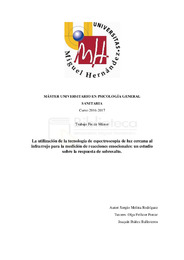Por favor, use este identificador para citar o enlazar este ítem:
https://hdl.handle.net/11000/5940Registro completo de metadatos
| Campo DC | Valor | Lengua/Idioma |
|---|---|---|
| dc.contributor.advisor | Pellicer Porcar, Olga | - |
| dc.contributor.advisor | Ibáñez Ballesteros, Joaquín | - |
| dc.contributor.author | Molina Rodriguez, Sergio | - |
| dc.contributor.other | Departamentos de la UMH::Psicología de la Salud | es |
| dc.date.accessioned | 2020-04-08T08:26:19Z | - |
| dc.date.available | 2020-04-08T08:26:19Z | - |
| dc.date.created | 2017-09 | - |
| dc.date.issued | 2020-04-08 | - |
| dc.identifier.uri | http://hdl.handle.net/11000/5940 | - |
| dc.description.abstract | La respuesta de sobresalto ha sido ampliamente estudiada en contextos básicos y aplicados, utilizando instrumentos de medida que, sin embargo, adolecen de determinadas limitaciones. En este sentido, la tecnología de luz cercana al infrarrojo (NIRS, por sus siglas en inglés) ha mostrado buenos resultados midiendo la respuesta emocional y se erige como un método que podría superar dichas limitaciones. Dicha técnica consiste en la medición de la respuesta hemodinámica, en términos de hemoglobina oxigenada y desoxigenada, en la frente y la corteza cerebral. El objetivo del presente trabajo es valorar la respuesta de sobresalto mediante NIRS en la frente. Para ello se registró la respuesta hemodinámica de 12 sujetos en dos condiciones: neutral, en la que observaban imágenes sin contenido emocional, y sobresalto, en la que se genera dicha reacción mediante un sonido fuerte. Los resultados mostraron diferencias significativas en la respuesta hemodinámica de la frente, observándose mayor respuesta hemodinámica en la condición sobresalto. De esta forma, la tecnología NIRS parece un método adecuado para valorar reacciones emocionales relacionadas con la ansiedad, y puede constituir una herramienta de utilidad en contextos básicos y aplicados. | es |
| dc.description.abstract | The startle response has been extensively studied in basic and applied contexts, using measurement instruments that, however, suffer from certain limitations. In this regard, near-infrared spectroscopy (NIRS) has shown good results by measuring emotional response and stands as a method that could overcome such limitations. This technique consists of measuring the hemodynamic response, in terms of oxygenated and deoxygenated hemoglobin, in the forehead and the cerebral cortex. The aim of the present study is to assess the startle response by NIRS on the forehead. For this purpose, the hemodynamic response of 12 subjects was registered in two conditions: neutral, in which they observed images without emotional content, and startle, in which this reaction is generated by a strong sound. The results showed significant differences in the hemodynamic response of the forehead, observing a greater hemodynamic response in the startle condition. In this way, NIRS seems to be a suitable method to assess anxiety-related emotional reactions, and can be a useful tool in basic and applied contexts. | es |
| dc.format | application/pdf | es |
| dc.format.extent | 29 | es |
| dc.language.iso | spa | es |
| dc.rights | info:eu-repo/semantics/openAccess | es |
| dc.subject | NIRS | es |
| dc.subject | Sobresalto | es |
| dc.subject | Emoción | es |
| dc.subject | Hemodinámica | es |
| dc.subject | Ansiedad | es |
| dc.subject.other | CDU::1 - Filosofía y psicología::159.9 - Psicología | es |
| dc.title | La utilización de la tecnología de espectroscopia de luz cercana al infrarrojo para la medición de reacciones emocionales: un estudio sobre la respuesta de sobresalto. | es |
| dc.type | info:eu-repo/semantics/masterThesis | es |

Ver/Abrir:
MOLINA Rodriguez Sergio TFM.pdf
1,12 MB
Adobe PDF
Compartir:
 La licencia se describe como: Atribución-NonComercial-NoDerivada 4.0 Internacional.
La licencia se describe como: Atribución-NonComercial-NoDerivada 4.0 Internacional.
.png)